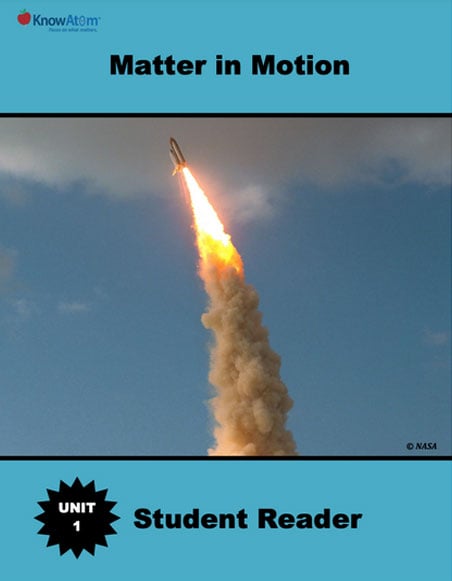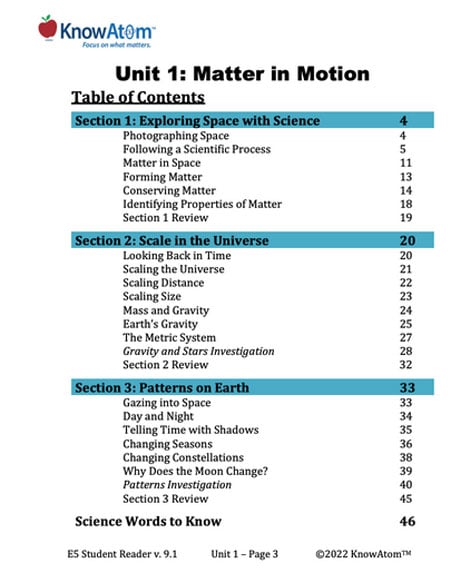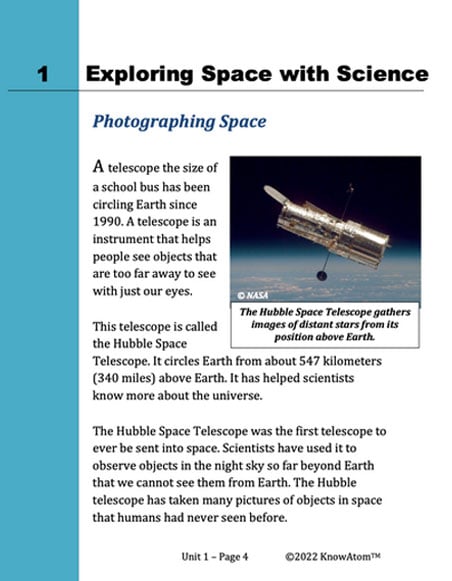Science background gives teachers more in-depth information about the phenomena students explore in this unit on matter. Below is an excerpt from the science background section on the conservation of matter.
The launch of the Hubble Space Telescope in 1990 allowed images of the universe to be taken without Earth’s atmosphere in the way, which distorts and blocks some light from the stars. This occurs because Earth’s atmosphere is made of matter—everything that has mass and takes up space. Matter makes up all of the substances in the universe.
All matter is made of atoms, which are the smallest pieces of matter that have the properties of an element. An element is a substance made up entirely of one kind of atom. Atoms are so tiny that we cannot see them. Just one grain of sand is made up of many millions of atoms. Because of this, scientists use scale to better understand the size of an atom, the parts that make it up, and how it relates to everyday substances. Scale is the size, extent, or importance (magnitude) of something relative to something else. For example, think about all of the atoms that make up a grapefruit. If each atom were the size of a blueberry, the grapefruit would be the size of Earth. There are so many atoms in just one grapefruit that they are impossible to count. Imagine having to fill up the entire planet with blueberries. That’s about how many atoms are in one grapefruit.
Atoms themselves are made up of smaller particles, called protons, neutrons, and electrons. These smaller particles are called subatomic particles because they are much smaller than the atom itself. For example, the protons and neutrons group together in the atom’s core, called the nucleus. The nucleus is very dense because it holds all of the atom’s protons and neutrons. Most of the atom is filled with empty space. The electrons are in constant motion around the nucleus, but there are vast regions of space between each of the electrons and between the electrons and the nucleus.
Matter’s properties change as atoms form bonds and combine. Atoms joined together are called molecules, which are formed as a result of a chemical reaction between two or more atoms. In a chemical reaction, the atoms that make up the original substances are rearranged into a new substance that has different properties from the original substance. Chemical reactions are not the same thing as physical changes. Physical changes are changes that do not affect the chemical structure of a substance. For example, if you cut up a piece of paper, it has changed shape but chemically it still has all the properties of paper.
In contrast, in a chemical reaction, the properties of the original substances are different from the properties of the resulting substances. For example, water (H2O) is a molecule made up of two hydrogen atoms and one oxygen atom. The properties of water are different from the properties of hydrogen and oxygen. For example, at normal room temperature, both oxygen and hydrogen are gasses. When atoms of hydrogen and oxygen join as a molecule of water, they change into a liquid. Additionally, unlike physical changes, the changes that occur during a chemical reaction generally cannot be reversed. A change in color or odor can be a sign that a chemical reaction has taken place. Also, if a gas forms when two different substances are mixed together, a chemical reaction has occurred.
The total number of atoms does not change in a chemical reaction. This is because matter is never created or destroyed, a theory called the conservation of matter. This theory states that atoms are not created or destroyed in a chemical reaction. Instead, they are rearranged to form new substances. Because of this, the mass of any one element at the beginning of a reaction will equal the mass of that same element at the end of the reaction. For scientists to accurately measure the elements before and after a chemical reaction, they must conduct the reaction in a closed system, where matter is prevented from being added or removed from the system. In contrast, in an open system, some of the mass is transferred to the environment, which is impossible to measure.










